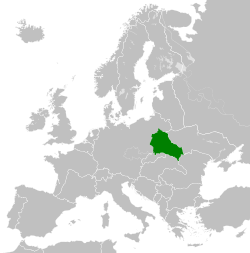General Governorate for the Occupied Polish Region Generalgouvernement für die besetzten polnischen Gebiete (German) | |||||||||||||
|---|---|---|---|---|---|---|---|---|---|---|---|---|---|
| 1939–1945 | |||||||||||||
 The General Government in 1942 | |||||||||||||
| Status | Administratively autonomous component of Germany[1] | ||||||||||||
| Capital | Litzmannstadt (12 October – 4 November 1939) Krakau (4 November 1939 – 19 January 1945) | ||||||||||||
| Common languages | German (official) Polish, Ukrainian, Yiddish | ||||||||||||
| Government | Civil administration | ||||||||||||
| Governor-General | |||||||||||||
• 1939–1945 | Hans Frank | ||||||||||||
| Secretary for State | |||||||||||||
• 1939–1940 | Arthur Seyss-Inquart | ||||||||||||
• 1940–1945 | Josef Bühler | ||||||||||||
| Historical era | Occupation of Poland in World War II | ||||||||||||
| 1 September 1939 | |||||||||||||
• Establishment | 26 October 1939 | ||||||||||||
• Galicia added | 1 August 1941 | ||||||||||||
| 22 July 1944 | |||||||||||||
| 17 January 1945 | |||||||||||||
• Disintegration | 19 January 1945 | ||||||||||||
| Currency | Zloty Reichsmark | ||||||||||||
| |||||||||||||
| Today part of | Poland Ukraine | ||||||||||||
The General Government (German: Generalgouvernement; Polish: Generalne Gubernatorstwo; Ukrainian: Генеральна губернія), formally the General Governorate for the Occupied Polish Region (German: Generalgouvernement für die besetzten polnischen Gebiete), was a German zone of occupation established after the invasion of Poland by Nazi Germany, Slovakia and the Soviet Union in 1939 at the onset of World War II. The newly occupied Second Polish Republic was split into three zones: the General Government in its centre, Polish areas annexed by Nazi Germany in the west, and Polish areas annexed by the Soviet Union in the east. The territory was expanded substantially in 1941, after the German Invasion of the Soviet Union, to include the new District of Galicia.[2] The area of the Generalgouvernement roughly corresponded with the Austrian part of the Polish–Lithuanian Commonwealth after the Third Partition of Poland in 1795.
The basis for the formation of the General Government was the "Annexation Decree on the Administration of the Occupied Polish Territories". Announced by Hitler on October 8, 1939, it claimed that the Polish government had totally collapsed. This rationale was utilized by the German Supreme Court to reassign the identity of all Polish nationals as stateless subjects, with the exception of the ethnic Germans of interwar Poland—who, disregarding international law, were named the only rightful citizens of Nazi Germany.[2]
The General Government was run by Germany as a separate administrative unit for logistical purposes. When the Wehrmacht forces invaded the Soviet Union in June 1941 (Operation Barbarossa), the area of the General Government was enlarged by the inclusion of the Polish regions previously annexed to the USSR.[3] Within days East Galicia was overrun and incorporated into the District of Galicia. Until 1945, the General Government comprised much of central, southern, and southeastern Poland within its prewar borders (and of modern-day Western Ukraine), including the major Polish cities of Warsaw, Kraków, Lwów (now Lviv, renamed Lemberg), Lublin (see Lublin Reservation), Tarnopol (see history of Tarnopol Ghetto), Stanisławów (now Ivano-Frankivsk, renamed Stanislau; see Stanisławów Ghetto), Drohobycz, and Sambor (see Drohobycz and Sambor Ghettos) and others. Geographical locations were renamed in German.[2]
The administration of the General Government was composed entirely of German officials, with the intent that the area was to be colonized by Germanic settlers who would reduce the local Polish population to the level of serfs before their eventual genocide.[4] The Nazi German rulers of the Generalgouvernement had no intention of sharing power with the locals throughout the war, regardless of their ethnicity and political orientation. The authorities rarely mentioned the name Poland in legal correspondence. The only exception to this was the General Government's Bank of Issue in Poland (Polish: Bank Emisyjny w Polsce, German: Emissionbank in Polen).[5][6]
- ^ Diemut 2003, page 268. Archived 2023-03-17 at the Wayback Machine
- ^ a b c Diemut Majer (2003). "Non-Germans" Under the Third Reich: The Nazi Judicial and Administrative System in Germany and Occupied Eastern Europe with Special Regard to Occupied Poland, 1939–1945. JHU Press. pp. 236–246. ISBN 0801864933. Archived from the original on 2023-03-17. Retrieved 2020-10-31.
{{cite book}}:|work=ignored (help) - ^ Piotr Eberhardt, Jan Owsinski (2003). Ethnic Groups and Population Changes in Twentieth-century Central-Eastern Europe: History, Data, Analysis. M.E. Sharpe. p. 216. ISBN 9780765606655. Archived from the original on 2023-03-17. Retrieved 2020-10-31.
- ^ Ewelina Żebrowaka-Żolinas Polityka eksterminacyjna okupanta hitlerowskiego na Zamojszczyźnie Studia Iuridica Lublinensia 17, 213-229
- ^ Keith Bullivant; Geoffrey J. Giles; Walter Pape (1999). Germany and Eastern Europe: Cultural Identities and Cultural Differences. Rodopi. p. 32.
- ^ Adam D. Rotfeld; Anatolij W. Torkunow (2010). White spots–black spots: difficult issues in Polish–Russian relations 1918–2008 [Białe plamy–czarne plamy: sprawy trudne w polsko-rosyjskich stosunkach 1918–2008] (in Polish). Polsko-Rosyjska Grupa do Spraw Trudnych, Polski Instytut Spraw Międzynarodowych. p. 378. ISBN 9788362453009. Archived from the original on 2023-03-17. Retrieved 2020-09-19..

